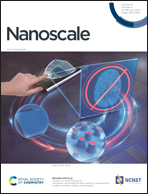Unveiling transient current response in bilayer oxide-based physical reservoirs for time-series data analysis†
Abstract
Physical reservoirs employed to map time-series data and analyze extracted features have attracted interest owing to their low training cost and mitigated interconnection complexity. This study reports a physical reservoir based on a bilayer oxide-based dynamic memristor. The proposed device exhibits a nonlinear current response and short-term memory (STM), satisfying the requirements of reservoir computing (RC). These characteristics are validated using a compact model to account for resistive switching (RS) via the dynamic evolution of the internal state variable and the relocation of oxygen vacancies. Mathematically, the transient current response can be quantitatively described according to a simple set of equations to correlate the theoretical framework with experimental results. Furthermore, the device shows significant reliability and ability to distinguish 4-bit inputs and four diverse neural firing patterns. Therefore, this work shows the feasibility of implementing physical reservoirs in hardware and advances the understanding of the dynamic response.



 Please wait while we load your content...
Please wait while we load your content...